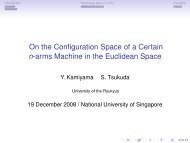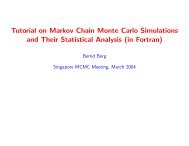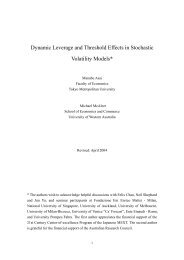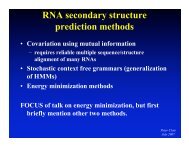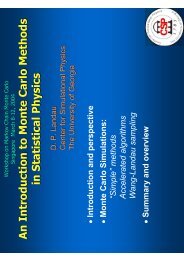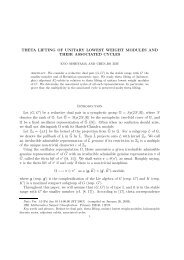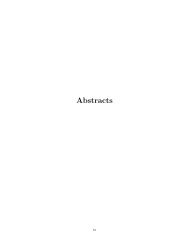Stein's method, Malliavin calculus and infinite-dimensional Gaussian
Stein's method, Malliavin calculus and infinite-dimensional Gaussian
Stein's method, Malliavin calculus and infinite-dimensional Gaussian
You also want an ePaper? Increase the reach of your titles
YUMPU automatically turns print PDFs into web optimized ePapers that Google loves.
h i<br />
t<br />
Since E exp tG (h) 2 2<br />
= 1, one deduces that (5.12) holds for every r<strong>and</strong>om variable of the<br />
<br />
t<br />
form F = exp tG (h) 2 2<br />
, with f n = tn<br />
n! hn . The conclusion is obtained by observing that<br />
the linear combinations of r<strong>and</strong>om variables of this type are dense in L 2 ( (G) ; P) :<br />
Remarks. (1) Proposition 4.2, together with (5.12), implies that<br />
E F 2 = E [F ] 2 +<br />
1X<br />
n! kf n k 2 L 2 ( n ) . (5.14)<br />
n=1<br />
(2) By using the notation (4.6), (4.13) <strong>and</strong> (4.14), one can reformulate the statement of<br />
Theorem 5.2 as follows:<br />
L 2 ( (G) ; P) =<br />
1M<br />
C n (G) ,<br />
n=0<br />
where “ ”indicates an in…nite orthogonal sum in L 2 (P).<br />
(3) By inspection of the proof of Theorem 5.2, we deduce that the linear combinations of<br />
r<strong>and</strong>om variables of the type I n (h n ), with n 1 <strong>and</strong> khk L 2 () = 1, are dense in L2 ( (G) ; P).<br />
This implies in particular that the r<strong>and</strong>om variables I n (h n ) generate the nth Wiener chaos<br />
C n (G).<br />
(4) The …rst proof of (5.12) dates back to Wiener [99]. See also McKean [50], Nualart <strong>and</strong><br />
Schoutens [68] <strong>and</strong> Stroock [91]. See e.g. [19], [35], [39], [43] <strong>and</strong> [72] for further references <strong>and</strong><br />
results on chaotic decompositions.<br />
6 Isonormal <strong>Gaussian</strong> processes<br />
In this section we brie‡y show how to generalize the previous results to the case of an isonormal<br />
<strong>Gaussian</strong> process. These objects have been introduced by Dudley in [22], <strong>and</strong> are a natural<br />
generalization of the <strong>Gaussian</strong> measures introduced above. In particular, the concept of an<br />
isonormal <strong>Gaussian</strong> process can be very useful in the study of fractional …elds. See e.g. Pipiras<br />
<strong>and</strong> Taqqu [76, 77, 78], or the second edition of Nualart’s book [65]. For a general approach to<br />
<strong>Gaussian</strong> analysis by means of Hilbert space techniques, <strong>and</strong> for further details on the subjects<br />
discussed in this section, the reader is referred to Janson [35].<br />
6.1 General de…nitions <strong>and</strong> examples<br />
Let H be a real separable Hilbert space with inner product h; i H<br />
. In what follows, we will denote<br />
by<br />
X = X (H) = fX (h) : h 2 Hg<br />
an isonormal <strong>Gaussian</strong> process over H. This means that X is a centered real-valued <strong>Gaussian</strong><br />
family, indexed by the elements of H <strong>and</strong> such that<br />
E X (h) X h 0 = h; h 0 H , 8h; h0 2 H: (6.1)<br />
19



